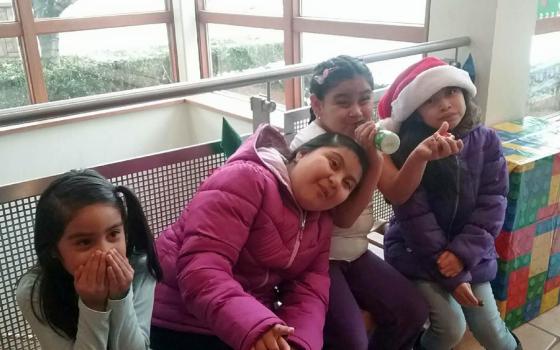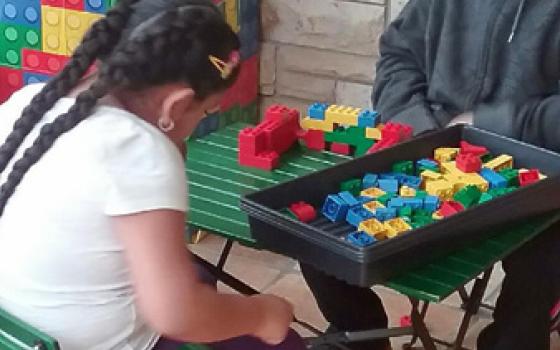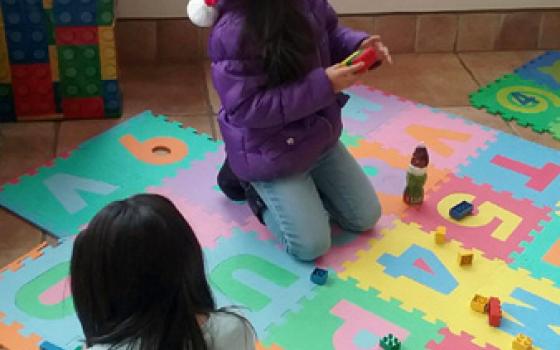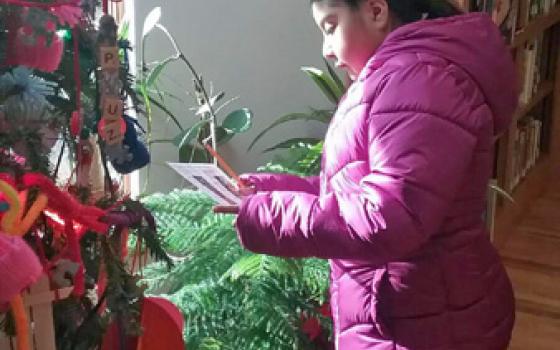Notes from the Field includes reports from young people volunteering in ministries of Catholic sisters. A partnership with Catholic Volunteer Network, the project began in the summer of 2015. This is our sixth round of bloggers: Natalia Liviero is a volunteer with VIDES+USA serving in the Middle East, and Janie Rosko is a Humility of Mary volunteer serving within the Ursuline Ministries in Youngstown, Ohio.
______
Samantha Williams, another Humility of Mary volunteer, and I have been organizing learning stations for the tutoring we do as part of the Immigrant Outreach Program at the Beatitude House on the west side of Youngstown. The stations are similar to the ones used for our summer program last year, except these will be in the basement classroom as opposed to the main classroom. They will be specialized areas consisting of reading, math, engineering/science, art, and games. We used these stations once last week; however, there are still additional materials needed for some of them.
We are still figuring out the most effective and appealing ways to use the stations. Our regular tutoring program occurs Wednesday evenings; however, Samantha and I work with some children on Monday evenings, too. There are women who care for babies and toddlers that use the same room on Tuesday and Thursday mornings, so we have to keep that in mind while designing our layout. We want make sure we prevent as many possible accidents as we have control over. For instance, the art station has beads, string, shells and other small articles that we need to assure are in a secure area so the babies cannot get a hold of them.
Murphy, a volunteer, helped us clean and organize the classroom over her winter break from college. She suggested we create a reading nook, possibly with bookshelves and a large sheet, to make an even more comforting atmosphere. We already have a carpet and two beanbag chairs that the children enjoy using while reading, so we hope to continue using those to our benefit.
The math area consists of a toy cash register and toy money. In the past, we have pretended to be in a store where the children were cashiers, and it is both educational and fun for them. There are also basic math flashcards, rulers, calculators, dominoes, and small blue blocks that teach place values (hundreds, tens, ones, etc.). Some of the materials used here will also be used for the engineering station, such as plastic geometric figures. The children have expressed a great amount of interest in these, as well as other building blocks.
The engineering/science station mainly consists of materials the children can use to build with and physically manipulate, including cut-up pieces of pool noodles and various pieces of PVC piping. It will also have magnifying glasses, various stones, mirrors, and items from nature, such as pinecones or leaves.
The art station has various types of construction paper, glue, scissors, crayons, markers, streamers, glitter, beads, string, stickers and paint. Every so often, we try to incorporate seasonally appropriate crafts in our program, such as wreaths, which may need other supplies that may not normally be in the art area.
The game station is where we will play board and card games. It is about having fun but also learning ways to cooperate, take turns, deal with wins and losses, and be fair to all participants. These social/emotional skills can be applied within all of the other stations, as well, although this station more overtly works with these aspects.
Teaching social/emotional skills to the children is high on our priority list. We try to take advantage of any opportunities where we can do this. On Dec. 28, Samantha, mentoring volunteer Courtney Conklin, and I brought five children we mentor to the Davis Education and Visitor Center in Mill Creek Park near the Fellows Riverside Gardens for its December event, "Winter Celebration: Toyland."
Various local organizations decorated pine trees that were spread out through the building with the Toyland theme in mind. The Davis Center staff took pictures of various ornaments or decorations and organized them on a sheet of paper as a scavenger hunt for any children (or adults) who wanted to participate.
The children we brought worked together to find the locations where the staff took the pictures. After verifying their success with the other children and volunteers, they would place a checkmark on the paper next to each one they found. This scavenger hunt helped them work on their cooperation skills.
In or out of the classroom, learning opportunities abound for the children. It is my duty and that of other staff and volunteers to seek out these possibilities and make the most of the time the children spend with us. We understand there are various other influences within the children's lives, but we hope to add to the positive ones.
Even though cooperation with others is an essential skill we hope to help the children improve, being able to act independently is also an indispensable skill. For instance, the last two objects on the scavenger list were difficult to find, even though the children had been searching for quite a while. There were various rooms where the objects could potentially be, and sometimes, a child would make the decision, independently going against the opinions of the other children, that we needed to search a specific previous area.
Teamwork is vital, but again, properly acting independently goes a long way. Whether we bring the children to a place such as the Davis Center or they are at Beatitude House working at a station, they must learn how to navigate the world independently. We hope to give the children necessary tools to aid them in their learning journey, and this involves both teamwork and independence.
[Janie Rosko is a Humility of Mary volunteer serving within the Ursuline ministries in Youngstown, Ohio.]




